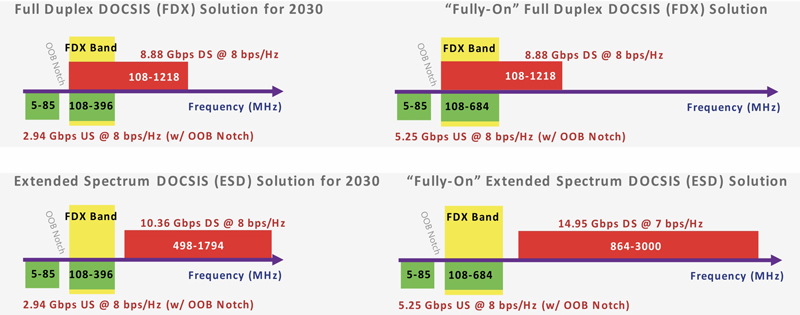10G on HFC — New Speeds for the Next Decade and Beyond
By Tom Cloonan
V slapped the alarm clock’s off button and opened his blood-shot eyes. “New Year’s Day 2020…” he whispered to himself. “Another year gone by.”
V was VP of Engineering at the local Cable Company — responsible for all HFC planning. The stress had been high, so he had partied hard the night before — and was feeling it. His plans called for a quiet day — football on TV while recovering from the hangover. But then he shook off the haze in his head and jumped out of bed.
“This is no time to relax! Something big is happening! This is a new decade! It’s the 2020s!” he exclaimed. “Everything in the DOCSIS/HFC network is about to change in this decade — in ways people could never imagine!”
His realization woke W, his wife. She calmly asked: “What’s changing?”
V shouted “EVERYTHING! First, new competitive threats are developing. Wireless 5G is arriving with extended frequency ranges and small cells to provide more capacity per subscriber. Telco-based PON solutions are also becoming more powerful, with XGS-PON getting deployed with capabilities of reaching symmetrical 8.6 Gbps capacities for the 2020s. These threats will create new pressures driving maximum throughputs (Tmax) to much higher levels. Perhaps the downstream (DS) CAGRs won’t grow at the Nielson’s 50% rate, but even if they slow to 25%, that is still a lot of growth on already-large Gbps numbers. And the upstream (US) Tmax levels will likely have to be boosted a lot to compete with more symmetrical services.
“Second, subscribers are demanding more! Average, busy-hour, per-subscriber DS throughput (Tavg) CAGRs have slowed in the past few years to ~39%, but the US Tavg CAGRs have held at ~19%. DS and US Tavg values are still growing at an exponential rate, and those yearly increments add up. Plus, there could be new apps — perhaps 8K IPTV, 5G backhaul/fronthaul, 3D light field displays, or VR will drive the Tavg CAGRs up even faster!”
W looked concerned. “Can you predict future needs?”
V responded. “We can make some guesses using traffic engineering math. In 2020, our DS Tavg=2.7 Mbps (with perhaps a reduced CAGR of 25% into the 2020s) and DS Tmax=1 Gbps (also with a 25% CAGR guess). Our 2020 US Tavg=170 kbps (with an expected 19% CAGR) and US Tmax=35 Mbps — but the marketing team wants to push US Tmax values to be ~25% of the DS Tmax in the future. The math predicts that by 2030, we may see DS Tavg=25 Mbps, DS Tmax= ~8 Gbps, US Tavg=970 kbps, and US Tmax=2 Gbps. We can guess that we may have a Node+1 network by 2030, with 120 subscribers in a 4×4 node and the number of subscribers in a service group given by Nsub=30.
“Using CommScope’s traffic engineering formulas (DS Capacity = Nsub*Tavg + 1.2*Tmax and US Capacity = Nsub*Tavg + 1.1*Tmax), we determine our 2030 required DS and US bandwidth capacities. 2030 DS Capacity = 10.35 Gbps, and 2030 US Capacity = 2.23 Gbps. Our 2030 plant may have many OFDM channels and permit average spectral efficiencies of (say) 8 bps/Hz, so we then can calculate that the required 2030 DS spectral width = 1.29 GHz and the required 2030 US spectral width = 278 MHz. Those spectral widths are more than our HFC plant currently supports! And we may need even more if PON or 5G deployments force higher Tmax values or if subscribers demand higher Tavg values!”
“What will you do?” queried W.
V thought. “One option is to transition from HFC to PON. But the labor cost of pulling fiber to every subscriber’s home and performing a ubiquitous swap-out of technologies from HFC to PON is quite high. Perhaps it can be done in some select locations and maybe in more locations in the future, but it’s too expensive right now.”
V realized he needed an evolutionary path. “There must be some way to leverage our existing HFC infrastructure to stay competitive and dominate this next decade of broadband the way that we did in the past two decades — making incremental and phased changes at various locations at various times, spreading the upgrade costs out over time and keeping costs minimized.”
He then remembered that much of his outside plant was installed in the 1990s and needed upgrading or replacing in the 2020s. “Perhaps that’s an opportunity? Perhaps we can refresh the aging nodes and amps with newer nodes and amps (ideally plug-ins) that support the higher spectral widths needed to operate to 2030 and beyond?”
W replied “You’ll need some help with this idea. Call S. He’s your favorite DOCSIS/HFC supplier. I’m sure he’d be happy to chat.”
V made the call, and S answered his questions. “There are many new, powerful technologies that are being developed — digital optics, DAA, RPD, RMD, virtualization, LLD, and LLX. All great technologies that may help. But you may need something stronger to make it into the 2030s.”
Then S had a brainstorm. “Do you recall that new 10G Initiative proposed by cable execs at CES 2019? Some folks thought it was just a futuristic marketing campaign at first. Well… maybe it’s more than marketing. Maybe it’s the answer to your problem!
“10G is a collection of technologies aimed at delivering 10 Gbps symmetrical services to subscribers. Interestingly, 10G permits wireless, PON, and DOCSIS/HFC to be used separately or together. 10G focuses on improving four key areas — security, reliability, lower latency, and higher speed. That last area is the one that can help you. And we are already working on 10G speed improvements in our DOCSIS/HFC equipment.
“10G for DOCSIS/HFC networks has already received attention within DOCSIS 4.0, which defines features related to low latency DOCSIS (LLD), full duplex (FDX) DOCSIS, and extended spectrum DOCSIS (ESD). The spec is maturing quickly.
“Let me email you Figure 1 showing spectral maps permitted by FDX (on the top) and ESD (on the bottom). Those are two potential solutions for supporting your bandwidth needs to 2030 and beyond.

“The FDX solution focuses on US augmentation using overlapping spectra and echo-cancellation, permitting simultaneous US and DS transmissions at one frequency. It supports the 2 Gbps US Tmax required for 2030. However, if your DS plant is limited to 1218 MHz, then this FDX solution alone will not quite provide for 2030’s DS Tmax of 8 Gbps. It only offers ~8.88 Gbps of total DS capacity, supporting a DS Tmax of ~6 Gbps. In addition, your plans to use a Node+1 network requires support for true FDX amps, and the performance of those FDX amp products are still being evaluated. FDX may be better suited for a Node+0 network — TBD.
“The ESD solution provides both US and DS augmentation using US ultra-splits (to 300, 396, 492, or 684 MHz) and extended DS top-end frequencies (to 1794 or 3000 MHz). 1794 MHz operation likely will appear before 3000 MHz, but we are trying to create housings to support both. These higher frequencies will require tap change-outs, but you have time. ESD uses traditional frequency division duplexing (FDD), separating the DS spectrum from the US spectrum… no overlapping spectra or echo-cancellation. Echo-cancellation could reduce guard-band sizes between spectra. ESD can easily support the 2 Gbps US Tmax and 8 Gbps DS Tmax required for 2030. Its “fully-on” 3000 MHz solution can even provide ~5 Gbps of US capacity and ~15 Gbps of DS capacity for higher Tmax values in the future. A dynamic soft-FDD version could even support capacities exceeding XGS-PON capacities. And it works in Node+X networks, where X>=0.”
V felt the weight lift off his shoulders. “So I have two options to help move to 2030 and beyond? FDX and ESD — I like it. What a relief. I am actually looking forward to going back to work now!”
“Glad I could help” S replied. “We can dive into details of these future products later.”
V hung up the phone and looked at his wife with a new sparkle in his eye. “W — Have I told you that you look beautiful today?”
W recognized that look and smiled invitingly, anticipating what would come next. “What about your hangover?”
V grinned. “10G took care of that… and all my other problems, too. Soooo… Let’s go watch football…”

Tom Cloonan,
CTO, Network Solutions,
CommScope
Tom Cloonan is the CTO- Network Solutions at CommScope. He has held that position since starting Cadant in 1999, and is responsible for directing the architectural work and future product planning for network products. His work has resulted in over 60 patents and over 100 published papers. He has also co-authored several technical books. Tom has a BSEE, MSEE, and Ph.D in Physics. He is also a Fellow of the IEEE and a Cable Pioneer.
Shutterstock



